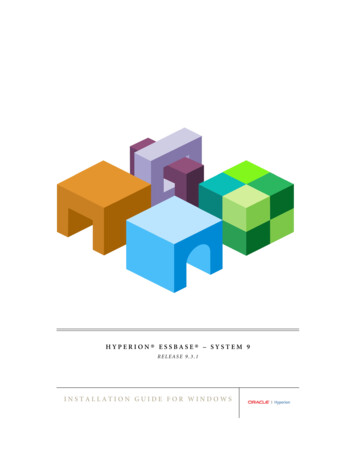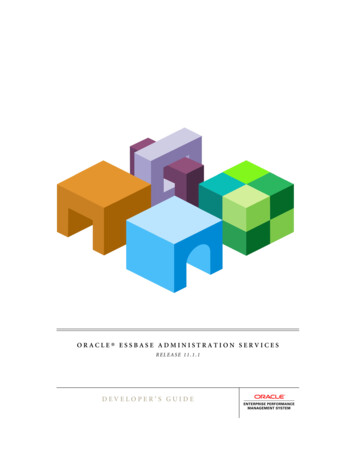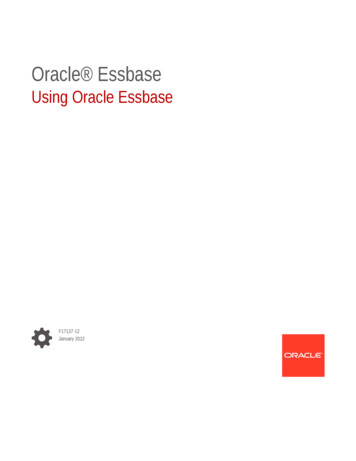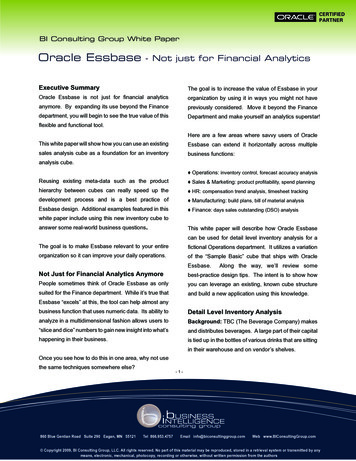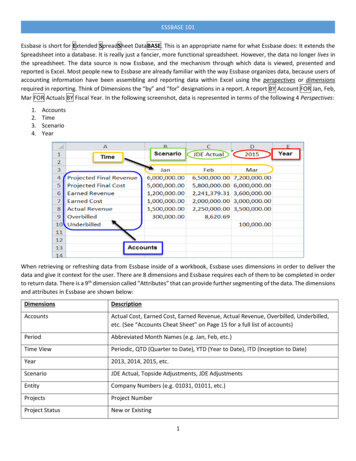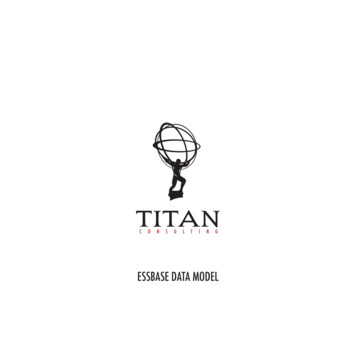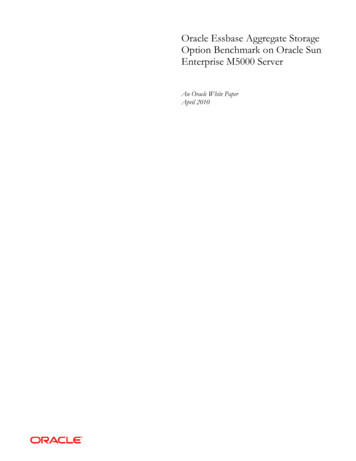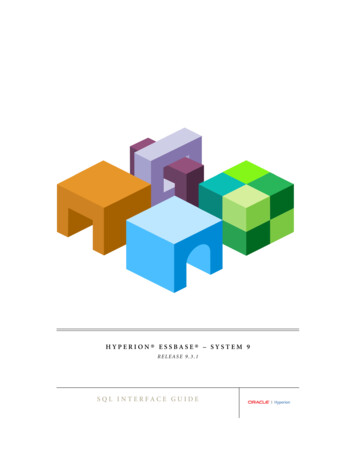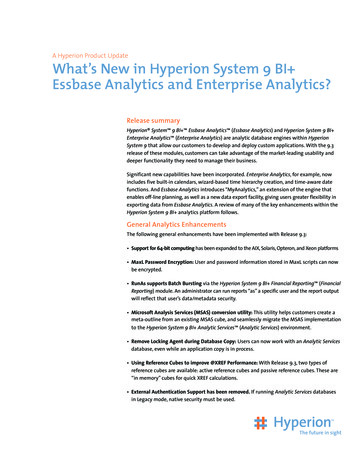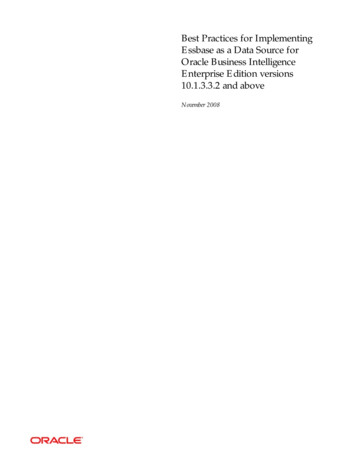
Transcription
Best Practices for ImplementingEssbase as a Data Source forOracle Business IntelligenceEnterprise Edition versions10.1.3.3.2 and aboveNovember 2008
1 BackgroundOracle Business Intelligence Suite Enterprise Edition is an enterprise Business Intelligence platformwith the ability to source from multiple heterogeneous data sources to enable pervasive businessanalytics. Oracle Business Intelligence Enterprise Edition releases (10.1.3.3.2 and higher) supportOracle Essbase as a physical data source. Essbase participates in the Common EnterpriseInformation Model (which allows integration with the other data sources in the enterprise), to buildBI content that can be deployed to a broad user audience through Oracle BI Dashboards, Answers,and Delivers.The purpose of this document is to highlight the features and limitations of the Oracle BI Serverconnectivity to Essbase, and to provide modeling techniques that utilize Essbase as a source withinOracle Business Intelligence.2 Oracle Essbase Versions Supported with Oracle Business IntelligenceOracle Business Intelligence supports Essbase version 7.1.6 and higher. Specific certified versionsare documented in System Requirements and Supported Platforms for Oracle BI Suite Enterprise Edition.3 Enabling the use of Oracle Essbase as a Data Source for the Oracle BI Server3.1 Essbase Client LibrariesOracle BI Server connectivity to Essbase is through the Essbase client libraries. The client librariesmust be installed on the Oracle BI Server. Please see the most current System Requirements andSupported Platforms for Oracle Business Intelligence Suite Enterprise Edition document for the supportedversions of the Essbase Client and corresponding Essbase Server versions for connectivity to theOracle BI Server.On Windows installations, the client installer typically configures environment variables correctly.To avoid possible issues, make sure that the PATH, ARBORPATH, and HYPERION HOMEvariables are set correctly.Note that there is no relationship between the Essbase Server being 32-bit or 64-bit and whether theclient is 32-bit or 64-bit, e.g. for example a 32-bit client can access a 64-bit server.3.2 BI Server Client Configuration for UNIX and Linux SystemsPerform the following configuration steps to access the Essbase client libraries through the BIserver on UNIX and Linux Platforms:Solaris: Oracle BI Server 64 bit mode:1. Define ARBORPATH Essbase Client installation folder For example:Page 2
ARBORPATH /export/home/Hyperion/AnalyticServicesClientexport ARBORPATH2. Add the Essbase Client Libraries folder to LD LIBRARY PATH:LD LIBRARY PATH 64 LD LIBRARY PATH 64: Essbase Client Libraries folder For example:LD LIBRARY PATH 64 LD LIBRARY PATH 64: ARBORPATH/binexport LD LIBRARY PATH 64Solaris: Oracle BI Server 32 bit mode1. Define ARBORPATH Essbase Client installation folder For example:ARBORPATH /export/home/Hyperion/AnalyticServicesClientexport ARBORPATH2. Add the Essbase Client Libraries folder to LD LIBRARY PATH:LD LIBRARY PATH LD LIBRARY PATH: Essbase Client Libraries folder For example:LD LIBRARY PATH LD LIBRARY PATH: ARBORPATH/binexport LD LIBRARY PATHHP-UX PARISC: Oracle BI Server 32 bit mode1. Define ARBORPATH Essbase Client installation folder For example:ARBORPATH /export/home/Hyperion/AnalyticServicesClientexport ARBORPATHPage 3
2. Add the Essbase Client Libraries folder to SHLIB PATH:SHLIB PATH SHLIB PATH: Essbase Client Libraries folder For example:SHLIB PATH SHLIB PATH: ARBORPATH/binexport SHLIB PATHHP-UX Itanium: Oracle BI 64 bit mode1. Define ARBORPATH Essbase Client installation folder For example:ARBORPATH /export/home/Hyperion/AnalyticServicesClientexport ARBORPATH2. Add the Essbase Client Libraries folder to SHLIB PATH:SHLIB PATH SHLIB PATH: Essbase Client Libraries folder For example:SHLIB PATH SHLIB PATH: ARBORPATH/binexport SHLIB PATH3. Define ESSLANG and LANGFor example:ESSLANG English UnitedStates.UTF-8@Binaryexport ESSLANGLANG en US.utf8export LANG4. Comment out the following three lines from the NQSConfig.ini file:[ GENERAL ]// Localization/Internationalization parameters.LOCALE "English-usa";SORT ORDER LOCALE "English-usa";SORT TYPE "binary";AIX: Oracle BI Server 32 and 64 bit mode1. Define ARBORPATH Essbase Client installation folder Page 4
For example:ARBORPATH /export/home/Hyperion/AnalyticServicesClientexport ARBORPATH2. Add the Essbase Client Libraries folder to LIBPATH:LIBPATH LIBPATH: Essbase Client Libraries folder For example:LIBPATH LIBPATH: ARBORPATH/binexport LIBPATHLinux: Oracle BI Server 32 bit mode1. Define ARBORPATH Essbase Client installation folder For example:ARBORPATH /export/home/Hyperion/AnalyticServicesClientexport ARBORPATH2. Add the Essbase Client Libraries folder to LD LIBRARY PATH:LD LIBRARY PATH LD LIBRARY PATH: Essbase Client Libraries folder For example:LD LIBRARY PATH LD LIBRARY PATH: ARBORPATH/binexport LD LIBRARY PATH4 Creating BI Server MetadataThe "Import from Multi-Dimensional" menu option in the Oracle BI Administration tool is used tocreate BI Server Physical layer metadata necessary to access Essbase cubes for reporting andanalysis. The following illustrations outline the process of creating Oracle BI Server metadata forEssbase.Page 5
In the “Import from Multi-Dimensional” dialog, select Essbase as the provider type. Input theserver and authentication information. For the import process, you will need to specify an EssbaseAdmin user. This ensures that substitution variables available on the Essbase Server are imported.After import, the connection pool to the Essbase Server can be re-configured for use only for theinitialization block that is used to retrieve substitution variables and their values. Additionalconnection pools can be added for end-user access.After selecting “OK”, a list of applications and cubes available on the Essbase Server is displayed.Page 6
The Administrator then has the option of selecting either Essbase applications or cubes to import.The example below shows how this is displayed in the physical layer. Note that Essbase applicationsare mapped as Physical catalogs.After import you will notice that the physical cube consists of a collection of dimension objects andmeasure objects. Essbase generations will be mapped to BI Server levels. Essbase measuredimension members will be imported as a flat list of BI Server measure columns. No other memberdata will be imported into the BI Server metadata.Once the physical cubes are imported, you can drag and drop them into the Business Model andMapping Layer to automatically create a Business Model that includes associated dimensions. TheBusiness Model can then be customized to take advantage of BI Server capabilities such as aggregateand fragment navigation.Page 7
4.1 Subsequent Changes to the Essbase OutlineEssbase outline changes are generally of two types: New dimension membersNew dimension members (other than measure members) are transparent to the BI Server, asmember data is not imported into the BI Server metadata. Cube structure changesCube structure changes (that is, adding or deleting dimensions, and levels) require either are-import of the cube, or manual modification to the BI Server physical metadata objects toreflect changes.If new dimension members are added to the Essbase outline while cache is enabled, cache will needto be cleared to ensure new members are accessed on subsequent queries.5 Adjusting Physical Layer Metadata PropertiesThe following topics should be considered when modifying physical layer metadata properties:5.1 Unqualified Member NamesAfter importing the cube object into the Physical layer, the “Use unqualified member name forbetter performance” check box is selected by default. This check box must be cleared if thehierarchy contains duplicate or shared member names.5.2 Unbalanced HierarchiesAll hierarchies are imported with a Hierarchy Type value of “Fully Balanced”. If a hierarchy isunbalanced you must change the Hierarchy Type value to “Unbalanced”.Page 8
How an unbalanced hierarchy behaves in a report is illustrated below:Notice that measure data is reported for the leaf member.Unbalanced hierarchy support in Oracle Business Intelligence (release 10.1.3.3.2 and higher) is forEssbase only, and does not extend to other multi-dimensional or relational sources.As indicated earlier Essbase generations are mapped to Oracle Business Intelligence levels uponimport. Essbase levels (which are numbered starting from the leaf levels), are not imported. Thisrestricts the ability to perform reporting on members at explicit Essbase levels. For example, in thecase of an unbalanced hierarchy, members at level 0 in an Essbase outline will have a varyingPage 9
generation number. Since only Essbase generation information is mapped in the Oracle Businessintelligence metadata (that is, mapped to an Oracle Business Intelligence level), explicit reporting onlevel 0 members is not possible.5.3 Aggregation TypeFor physical layer measure columns, the aggregation rule is set to Aggr External by default. Thissetting allows Essbase to optimally access aggregate values. However, there are cases where anexplicit aggregation rule is necessary. These cases will be described later in this document.5.4 Measure HierarchiesEssbase supports the concept of measure hierarchies. Measure hierarchies allow end users to drillfrom a measure to components that make up the measure (for example, you could drill from profitto revenue and costs). Oracle Business Intelligence does not support measure hierarchies. Measuremembers are imported as a flat list of columns that belong to the cube itself.There are scenarios where it may make sense to designate an alternate hierarchy as the OracleBusiness Intelligence measure hierarchy. This is typically the case with the Accounts dimension,which by default is treated as a measure hierarchy. For this case, an alternate dimension (forexample, Scenario), can be used as the measures hierarchy in the BI Server metadata. The followingexample illustrates the process of swapping the Accounts dimension for the Scenario dimension asthe measures hierarchy:Default behavior:Page 10
Desired behavior:The desired behavior is achieved with the following steps:1. Using the “Demo.Basic” cube as an example, after import, select the cube object and selectproperties.2. On the Hierarchies tab:a. Edit the properties of the Accounts dimension by changing the Dimension type to“Other”b. Edit the properties of the Scenario dimension by changing the Dimension type to“Measure Dimension”3. After changing the cube properties, you will then need to delete the existing measures fromthe BI Server metadata physical cube and add the members from the Scenario dimension(Actual, Budget, Variance)Page 11
6 Other Modeling Techniques6.1 Federation with other data sourcesOracle Business Intelligence supports joining of Essbase data with other data sources in a singlereport. Federation requires that Essbase dimensions conform across the disparate sources. Acommon use case where dimensions may be non-conforming is analysis along the Accountsdimension. In this case, Account members at a given logical level may exist in Essbase in variousgenerations. Since the BI Server assigns generations to explicit levels, the Server cannot determinethe logical level information for a given Account member. Federation cannot be modeled for thisscenario.Example federation use cases are described below:1) Disparate facts: Forecast data is available for Region level data in Essbase. Actual data isavailable for Regions in relational.2) Disparate fact sources: Unit Sales are available at aggregated levels in Essbase (State and above).Unit Sales are available at a detailed level (City) in relational. There is a common dimension level(State) across Essbase and relational at which a join can be made.In general, federation with Essbase can be achieved when all of the following conditions are met:1) There is a conforming dimension(s) between Essbase and the disparate source.2) For the conforming dimension, there is a common level with common data at which bothsources can be joined3) For the Essbase dimension, members at the same logical level exist in one and only onegeneration.4) The BI Server assumes that measure data can be retrieved at or above the level specified in thelogical fact source for the Essbase source.When modeling federation:1) Ensure the level is set appropriately for both the dimension and fact table sources.2) Set the aggregation rule for the logical fact column to an explicit rule.The following illustration describes modeling federation for a drill-through use case:I can view Total Sales (sourced from Essbase) for States. I now want to see the transaction detailsfor each City within a State.By modeling the repository such that the “Sales” logical column is sourced from Essbase for Stateand above (logical table source for aggregated data) while the detailed transactions are mapped to anOracle DB (LTS for detailed transactional data), the BI Server will seamlessly navigate from anEssbase cube to the Oracle RDB for transaction level details when a user drills down from the TotalSales for State to the City level.Page 12
Note that when federating on the Time dimension, multiple sources for time series calculations arenot supported.6.2 Time Series FunctionsOracle BI Server Time Series functions, Ago and ToDate, are supported for use with Essbase. TheBI Server function-ships the appropriate time series functions to Essbase.6.3 Evaluate Function for MDX SourcesIn Oracle Business Intelligence Enterprise Edition (release 10.1.3.3.2 and higher) you can useEvaluate expressions to leverage functions for Essbase. Note that different versions of Essbase havevariations in the native functions supported. An Evaluate expression that works against one versionof Essbase may not necessarily work in another version of Essbase.Support for Evaluate does not extend across all multi-dimensional sources at this time.The following use case examples use the EVALUATE AGGREGATE and EVALUATEfunctions. Note that expressions are applied to columns in the Logical Table Source that refers tothe physical cube:Page 13
EVALUATE AGGREGATE is used to implement custom aggregations. For example, the usermay want to compare overall regional profit to profits for the top 3 products in the region. A newmeasure can be defined to represent the profits for top 3 products resulting in the logical SQLstatement:Select Region, Profit, EVALUATE AGGREGATE('SUM(TopCount(%1.members, 3, %2),%3)', Products, Profit, Profit) Top 3 prod Profit From SampleBasicThe Oracle BI Server will generate the following expression for the custom aggregation:member [Measures].[MS1] ly, the EVALUATE function can be used implement scalar functions that are computed postaggregation. EVALUATE will change the grain of the query, if its definition makes explicitreferences to dimensions (or attributes) that are not in query.Let’s say the user would like to see the Profits for the top 5 products ranked by Sales sold in aRegion, after creating the applicable measure, the resulting Logical SQL statement is as follows:Select Region, EVALUATE(‘TopCount(%1.members, 5, %2)’ as VARCHAR(20), Products,Sales), ProfitsFrom SampleBasicThe Oracle BI Server will generate the following expression to retrieve the top 5 products:set [Evaluate0] as sures].[Sales]) }’6.4 Outline Sort OrderEssbase users may want to see dimension members returned in the order they are physically storedin the outline.There are two options that leverage the EVALUATE function to enable this view:1. In the metadata repository, create a Sort Order column (Recommended)2. In Answers, create a column solely used for sortingBy default, Answers returns dimension members in alphabetical (or numeric) orderThe following example compares default behavior with desired behavior.Page 14
DefaultDesiredIn order to achieve the desired results for this example::1. Define a new column in the metadata repository using an Evaluate expression (as shown in theillustration below).2. Use this new column as the “Sort Order” for the dimension where sort order needs to bepreserved.Note that the RANK function is only supported in Essbase 9.3 and higher.6.5 User-Defined AttributesEssbase supports the concept of user-defined attributes (UDAs). A UDA is essentially any arbitrarytextual string that can be associated with any member from a dimension. A member can havemultiple strings associated. The import process to build Oracle BI Server metadata does not retrieveUDA’s.Users can still query using UDAs by leveraging the EVALUATE function.Consider the following example where “Major Market” is a UDA.After creating the applicable column, the resulting logical SQL statement is as follows:Select EVALUATE(‘FILTER( %1.Members, isUDA([%2.Dimension, “Major Market”))’, State,State), SalesFrom SampleBasicThe Oracle BI Server will generate the following expression for the custom column:Page 15
set [Evaluate0] )) }'6.6 Alternate HierarchiesEssbase supports the concept of alternate hierarchies. Essbase alternate hierarchies are notautomatically created when dragging and dropping a cube from the repository Phyiscal layer tocreate a Business Model. Essbase’s alternate hierarchy can be modeled manually using the OracleBusiness Intelligence multiple hierarchy support.The recommended best practice is to model multiple hierarchies within Oracle Business Intelligencemetadata to avoid potential double-counting issues.Consider the following example using the ASOSample.Sample cube:In this cube, the All Merchandise hierarchy is as follows:Product Category - Product Type - Product SKU - Product Sub SKUThe High End Merchandise hierarchy contains members from Product CategoryTo add the alternate hierarchy, add a new logical table source to the Products folder and two newcolumns (High End Merchandise, High End Products) that correspond to the new hierarchy.Page 16
Next, in the Content tab of the new Logical Table Source, specify a filter on the “ProductHierarchy” column as illustrated below:Next, add the alternate hierarchy to the Products Dimension as illustrated below:One limitation to this modeling approach is that all multiple hierarchies in the Oracle BusinessIntelligence metadata must terminate at a common leaf member.6.7 Substitution VariablesEssbase substitution variables are automatically retrieved and populated into corresponding BIServer dynamic system variables. Depending on the scope of the Essbase variable, the naming convention for the BI Servervariable is as described below.Server instance scope server name : var name Application scope server name : app name : var name Cube scopePage 17
server name : app name : cube name : var name The refresh interval should be set appropriately to reflect anticipated update cycles forEssbase variables.6.8 Attribute DimensionsEssbase attribute dimensions are available upon import. However, member attributes are notautomatically associated with corresponding dimensions and levels during the import process. Tomanually create the association, the Oracle Business Intelligence Administrator may choose to:1. Map the member attribute to the appropriate logical table in the Business Model Layer or2. Include the attribute in the appropriate presentation table in the Presentation Layer6.9 Connecting to Multiple Nodes in an Essbase Server ClusterIt may be necessary to connect BI Server(s) to an Essbase Server cluster. Using BI Server sessionvariables it is possible to load balance Essbase server nodes using a round robin approach.General Instructions:1. Create a database-stored package with a function in any of the Oracle Business Intelligencesupported relational databases, which returns an Essbase node from a List of available /active Essbase nodes in a round-robin fashion.2. An external polling mechanism is required to constantly test the availability of the EssbaseNodes participating in the Clustered environment and should update the availability on Listof available/active Essbase nodes table maintained on the relational schema and used by thestored function.3. Using the Oracle Business Intelligence Administration Tool, create a session basedinitialization block to make a call to this stored function and a session variable that thisinitialization block will populate.4. Use this session variable as the Essbase Server node in the Connection Pool object createdfor the physical database object mapped to Essbase database.Detailed Instructions are provided in Appendix A.7 Other Considerations and Limitations7.1 Shared Members and Double Counting in Sub-TotalsWhen reporting on shared members, double-counting may occur with sub-totals in the followingscenarios:Page 18
1. Aggregation function other than ‘External Aggregate’ (example – SUM, AVG, COUNTetc.). An explicit aggregation rule may under some circumstances result in the BI Serverprocessing the aggregation. When the BI Server does the internal execution, the BI Servermay not have the member level metadata to suppress shared members.2. Filter below query grain – When you have a filter below the aggregate grain, the BI Servermay double counts shared members for all types of aggregation functions including‘External Aggregate’.7.2 Explicit Aggregation Rules for Essbase Measure ColumnsAs mentioned earlier there are cases where explicit aggregation rules need to be set for an Essbasemeasure column. This is generally driven by reporting requirements where the aggregation cannotbe “pushed” down to Essbase. Examples of these cases include:1. Use of logical column with expressions that cannot be pushed down to Essbase, e.g. CASEstatements2. Use of logical column expressions using EVALUATE to return a scalar list of members3. Filter expressions other than equivalencyFor these cases, performance will be degraded as aggregation is done on the BI Server rather than inEssbase.Additionally, when the Aggregation rule is set to “Aggr External” for Cube Measures in thePhysical layer, the BI Server issues MDX Aggregate functions for these Time balance measures.Essbase started supporting the Aggregate function in its MDX language starting from release 9.3.x.For users connecting to an Essbase cube versions prior to 9.3.1, these types of queries will fail withthe error message “Essbase Error: Unknown Member AGGREGATE used in query” and wouldhave to set the Aggregation rule as Sum for these cube members in the Physical and Business Modellayer.7.3 Member Name versus AliasWhen displaying members, the BI Server will return the default alias if available and the membername if a default alias is not available. We do not currently provide the capability for a user todynamically determine whether to display member name or values from alias tables.It is possible to add a workaround to implement a workaround to report on member name, if thedefault alias is not desired. This is only available for the lowest level in the dimension. Toimplement this:1) Add a column to the lowest level of the desired dimension in the physical layer. You can give itany name.2) In the “External Name” field, please type 'MEMBER NAME'.3) Set the data type to ‘VARCHAR’Page 19
7.4 SecurityLogin credentials used to authenticate for Oracle Business Intelligence can be propagated forauthentication by Essbase using the :USER, :PASSWORD variables in the connection pool.Note that erroneous data or even query errors may occur when the connection pool user queries fordata when a visibility restriction rule is applied to the data (#NoAccess). This issue is addressed in apatch for version 10.1.3.47.5 Combining Multiple Cubes into a Single Business ModelAs a general best practice, when the desire is to combine multiple cubes into a single businessmodel, we recommend using partitioning capabilities within the Essbase server. If this is notpossible and the desire is to model this in the Oracle Business Intelligence metadata, there areseveral considerations to keep in mind.Inconsistent query results may occur if a physical database or catalog folder of type Essbase isdragged from the Physical layer of the repository to the Business Model layer to create a singleBusiness Model.To work around this issue, you must take one of the following actions: If the Administrator wants to create a separate Business Model for each cube, then eachcube should be dragged individually to the Business Model layer. If a single Business Model is desired for each physical database or physical catalog, thedatabase or physical catalog can be dragged to the Business Model layer. However, by doingso, any dimensions with the same name will be treated as conforming dimensions and asingle Logical dimension will be created for all such dimensions. This means the Logicaldimension will be sourced from all such dimensions with the same name and hence may leadto potential query issues. It is the responsibility of the Administrator to correct the mappingsor to create individual logical dimensions for dimensions that are not conforming.When creating logical dimension sources, ensure that the fragmentation filter uses only a physicalcube column and not a derivation, and that the option to combine sources is checked.Page 20
Appendix A – Essbase ClusteringThe following detailed instructions enable you to create a clustered Essbase environment in the BIServer metadata:1. Create a Session-based Initialization Block as follows:a. Click Manage Æ Variables Æ Session Æ Initialization Blocks Æ New SessionInitialization Block b. Provide a name (data source init blk) for the initialization blockc. Click Æ “Edit Data Source ” buttoni. Select “Data Source Type” Æ Databaseii. For Default Initialization String, provide the following SQL:“select essClusterMgmt Pkg.getEssbaseNode fn()from dual”iii. Click Æ “Browse ” to select a Relational database based connection pool(which connects to a schema that contains the getEssbaseNode storedprocedure)iv. Click Æ “Test ” to test connectivity and check if the store procedurereturns desired results, that is Essbase Node.v. Click Æ OK to return to Initialization Block dialogd. Click Æ “Edit Data Target ” button to specify the Session variablei. Click Æ “New ” button to open Session Variable dialog1. Enter a name for the session variable (Essbase node), which will bepopulated with Essbase Node value returned by the InitializationBlock.2. Enter the following Description in the space provided:“This session variable will be populated with thenext available Essbase node value for eachUser session by data source init blkinitialization block and all subsequent queriesfor the User session will be sent to this Essbasenode for execution.”3. Click Æ OK to re turn to Session Variable dialogii. Click Æ OK to return to Initialization Block dialoge. Click “Required for Authentication” check boxf. Click Æ “Test ” button to test connectivity and check that essbase node sessionvariable is now populated correctly with the Essbase Node value returned by theinitialization block.g. Click Æ OK to close the dialog.Page 21
2. Use this Session variable in the Connection Pool object for Essbase data source.a. In the Physical Layer of Admintool, expand the physical database object that mapsto the Essbase databaseb. Double Click Æ Connection Pool object to edit the properties of this connectionc. Enter Æ “valueof(NQ SESSION.Essbase node)” in the Essbase Server Text box.d. Enter Æ “:USER” and “:PASSWORD” for the “User name” and “Password” in theConnection properties section.e. Leave the other settings as is.f. Click Æ OK to close the Connection Pool dialog.Page 22
Limitations: If an Essbase node goes down, the external polling mechanism should remove it from therelational table, so that stored function does not return this node and Oracle BusinessIntelligence doesn't use it any more until it is back on.If an Essbase node goes down, queries on active connections would fail and would requireyou to login again.Sample Oracle Database Package for Cluster Management:Table DDL:create table essbase clustered nodes (node num number, node name varchar2(100),node active varchar(1));Package DDL:/*Name: essClusterMgmt PkgAuthor: Deepak BhatiaPage 23
Created: 21-APR-2008Purpose: This package defines a function which returns an Essbase node from list ofactive nodes in a round-robin fashion.*/CREATE OR REPLACE PACKAGE essClusterMgmt Pkg ASg last returned node number;FUNCTION getEssbaseNode fn return varchar2;END essClusterMgmt Pkg ;/CREATE OR REPLACE PACKAGE BODY essClusterMgmt Pkg ASFUNCTION getEssbaseNode fn return varchar2ISl essnode name varchar2(50);l essnode num number;l max node num number;BEGINbeginselect max(node num) into l max node num from essbase clustered nodes wherenode active 'Y';if (nvl(g last returned node,0) l max node num) thenselect min(node num) into l essnode num from essbase clustered nodeswhere node num nvl(g last returned node,0) and node active 'Y';elseselect min(node num) into l essnode num from essbase clustered nodeswhere node active 'Y';end if;g last returned node : l essnode num;SELECT node name into l essnode name from essbase clustered nodes wherenode num l essnode num ;return l essnode name ;Exceptionwhen OTHERS thenbeginraise application error (-20001, 'Error: essClusterMgmt Pkg.getEssbaseNode fn:: Errorencountered. Ora Error: ' SQLERRM);Page 24
end;end;END getEssbaseNode fn;END essClusterMgmt Pkg ;/Page 25
Oracle CorporationWorld Headquarters500 Oracle ParkwayRedwood Shores, CA 94065U.S.A.Worldwide Inquiries:Phone: 1.650.506.7000Fax: 1.650.506.7200oracle.comCopyr
Essbase levels (which are numbered starting from the leaf levels), are not imported. This restricts the ability to perform reporting on members at explicit Essbase levels. For example, in the case of an unbalanced hierarchy, members at level 0 in an Essbase outline will have a varying .
